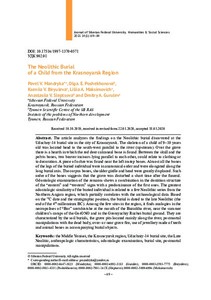The Neolithic Burial of a Child from the Krasnoyarsk Region
Скачать файл:
URI (для ссылок/цитирований):
https://elib.sfu-kras.ru/handle/2311/135213Автор:
Mandryka, Pavel V.
Poshekhonova, Olga E.
Biryuleva, Kseniia V.
Maksimovich, Liliia A.
Sleptsova, Anastasiia V.
Gurulev, Dmitry A.
Мандрыка, П.В.
Пошехонова, О.Е.
Бирюлева, К.В.
Максимович, Л.А.
Слепцова, А.В.
Гурулёв, Д.А.
Дата:
2021-01Журнал:
Журнал Сибирского федерального университета. Гуманитарные науки. Journal of Siberian Federal University. Humanities & Social Sciences; 2021 14 (1)Аннотация:
The article analyzes the findings on the Neolithic burial discovered at the
Udachny-14 burial site in the city of Krasnoyarsk. The skeleton of a child of 9–10 years
old was located head to the south-west parallel to the river (upstream). Over the grave
there is a hearth in which the red deer calcaneal bone is found. Between the skull and the
pelvis bones, two beaver incisors lying parallel to each other, could relate to clothing or
to decoration. A piece of ochre was found near the left instep bones. Almost all the bones
of the legs of the buried individual were in anatomical order and were elongated along the
long burial axis. The corpus bones, shoulder girdle and head were greatly displaced. Such
order of the bones suggests that the grave was disturbed a short time after the funeral.
Odontologic examination of the remains shows a combination in the dentition structure
of the “eastern” and “western” signs with a predominance of the first ones. The greatest
odontologic similarity of the buried individual is related to a few Neolithic series from the
Northern Angara region, which partially correlates with the archaeological data. Based
on the 14C date and the stratigraphic position, the burial is dated to the late Neolithic (the
end of the 4th millennium BC). Among the few sites in the region, it finds analogies in the
necropolises of “Bor” urotshistshe at the mouth of the Bazaikha river, near the summer
children’s camps of the GorONO and in the Gremyachiy Ruchei burial ground. They are
characterized by the soil burials, the grave pits located mainly along the river, postmortal
manipulations with the dead body, over- or near grave fire, use of jewellery made of teeth
and animal bones as accompanying burial objects Статья посвящена анализу материалов неолитического погребения,
обнаруженного на стоянке Удачный-14 в г. Красноярске. Скелет ребенка 9–10
лет располагался головой на юго-запад параллельно реке (против течения). Над
могилой отмечен прокал, в котором обнаружена пяточная кость благородного
оленя. Между черепом и костями таза зафиксированы два параллельно лежащих
резца бобра, которые могли относиться к деталям одежды либо к украшению.
Возле левых плюсневых костей найден кусок охры. Практически все кости ног
захороненного индивида находились в анатомическом порядке и были вытянуты
вдоль длинной оси захоронения. Кости туловища, плечевого пояса и головы были
значительно перемещены. Расположение костей дает основание предполагать,
что могила была потревожена через небольшой промежуток времени после
похорон. Одонтологическое обследование останков показало сочетание в
строении зубной системы «восточных» и «западных» признаков с преобладанием
первых. Наибольшее одонтологическое сходство погребенного фиксируется
с небольшой неолитической серией из Северного Приангарья, что частично
коррелирует с археологическими данными. На основании полученной 14C даты
и стратиграфического положения захоронение датировано поздним неолитом
(конец IV тыс. до н. э.). Среди немногочисленных памятников региона оно
находит аналогии в материалах некрополей из урочища «Бор» в устье р. Базаихи,
у летних детских дач ГорОНО и Гремячего ручья. Для них характерны грунтовый
характер погребений, расположение могильных ям преимущественно вдоль реки,
посмертные манипуляции с телом умерших, наличие следов надмогильного или
околомогильного костра, использование в качестве сопроводительного инвентаря
украшений из зубов и костей животных
Коллекции:
Метаданные:
Показать полную информациюСвязанные материалы
Показаны похожие ресурсы по названию, автору или тематике.
-
Коллективное погребение в сожжённом срубе на Оглахтинском могильнике: контекст, тафономия, ритуал
Зайцева, О. В.; Широбоков, И. Г.; Водясов, Е. В.; Учанева, Е. Н.; Каспаров, А. К.; Zaitseva, Olga V.; Shirobokov, Ivan G.; Vodyasov, Evgeny V.; Uchaneva, Evgeniia N.; Kasparov, Aleksei K. (Journal of Siberian Federal University. Сибирский федеральный университет, 2024-09)Статья посвящена комплексному анализу материалов коллективного погребения в сожжённом срубе из Оглахтинского могильника. В погребении находились останки трех человек, похороненных по обряду ингумации, а также семь ... -
Материалы средневековых погребений стоянки-могильника Сергушкин-3 (Нижнее Приангарье)
Сенотрусова, П. О.; Леонтьев, С. Н.; Герман, П. В.; Дедик, А.В.; Senotrusova, Polina O.; Leont’ev, Stanislav N.; German, Pavel V.; Dedik, Alena V. (Journal of Siberian Federal University. Сибирский федеральный университет, 2024-09)В статье представлены результаты изучения средневековых погребений могильника Сергушкин‑3. Десять погребений выполнены по обряду трупосожжения на стороне. Проанализированы особенности погребального обряда, выделены его ... -
Ecological Aspects of the Burial Rites Performed by Siberian Ethnic Groups: Sacral Topography of the Burial Sites of Narym Paleo-Selkups “Shieshgula”
Ozheredov, Yuri I.; Ozheredova, Alina Y.; Ожередов, Ю.И.; Ожередова, А.Ю. (Сибирский федеральный университет. Siberian Federal University, 2015-04)This study is meant to be the start toa series of discussions relating to the complex subject of the “Ecological aspects in the burial rites performed by Siberian ethnic groups ”. Taking into account that for aboriginals ... -
The History of Russian and Foreign Criminal Legislation on the Abuse of Corpses and Burial Places
Bondareva, Elena V.; Е. В. Бондарева (Сибирский федеральный университет. Siberian Federal University, 2008-06)This article gives a historical background and compares article 244 of the Russian criminal code, which provides the definition and punishment for corpse and grave abuse, with the laws of foreign countries for the same ... -
Early Iron Age Archaeology in Middle Siberia: The Relations Between Inhabitants of the Taiga and the Steppe
Mandryka, Pavel V.; П.В.Мандрыка (Сибирский федеральный университет. Siberian Federal University, 2008-06)The article presents new archaeological data for the Scythian period from the southern forest regions of Middle Siberia. The data reconstruct the relations between the taiga hunters and gatherers of the Angara River Basin ...

